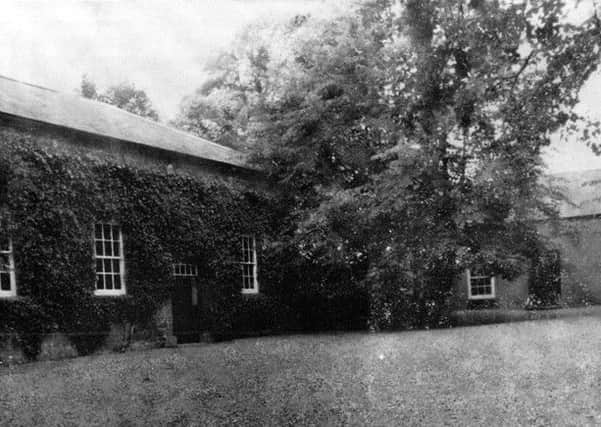Restored and refurbished meeting house with history dating back to 1660s


The note was from the Grange Quakers, near Dungannon, who’ve been renovating and redecorating their beautiful, ivy-clad meeting house on the Dreemore Road, not far from the M1.
A little, old, meeting house is still there, dating from 1756 and still in use, but the bigger ‘new’ one that’s soon being commemorated was built in 1816 and has recently been extensively restored and refurbished.
Advertisement
Hide AdAdvertisement
Hide AdOn Saturday and Sunday the 1st and 2nd October Grange Quakers are hosting a weekend of twin-track celebrations, marking the 1816 building’s bicentenary as well as its rebirth!
There’s a full history of Irish Quakers, who are also known as ‘Friends’, on Grange’s website, and many books have been written about them.
There are about 1,600 members in Ireland, and about 340,000 worldwide.
We’ve all heard of Friends School Lisburn, one of nine Quaker schools in Britain and Ireland.
Advertisement
Hide AdAdvertisement
Hide AdThe famous Lisburn school was the brainchild of the prosperous, Quaker linen merchant John Hancock who bequeathed £1,000 in 1764 for the purchase of land for a school for Quaker children.
Many local Quaker names were well-known in their various fields, such as the linen manufacturing Richardsons of Bessbrook, and Forster Green, the Belfast grocer, philanthropist and hugely successful tea and coffee merchant who was life Governor of the Royal Victoria Hospital and founder of Forster Green Hospital.
As well as the Friends Ambulance Corps, which operated from 1914-1919, 1939-1946 and 1946-1959 in 25 different countries around the world, internationally known Quakers include the chocolate barons - Cadbury, Rowntree and Fry.
U.S.A President Richard Nixon’s mother was a Quaker and his father converted from Methodism to his wife’s faith.
Advertisement
Hide AdAdvertisement
Hide AdWilliam Penn (1644 -1718), the English-born founder of Pennsylvania became a Quaker aged 22.
English prison reformer Elizabeth Fry (1780-1845) was a Quaker, and after his mother died when he was a child, heartthrob film-star James Dean was sent to a relative who raised him as a Quaker.
In today’s celebrity-orientated era the star-studded list of Friends includes Judi Dench, Sheila Hancock, Margaret Drabble, Ben Kingsley and the late, great, Paul Eddington and Gerald Priestland.
The section of John Hancock’s will in 1764 relating to Friends School specified that the school was to be regularly inspected by Quakers and that the headmaster was “to be a sober and reputable person.”
Advertisement
Hide AdAdvertisement
Hide AdThis was very much in keeping with the views of the founder of Quakerism, George Fox (1624-1691) who was born in Leicestershire, England.
As a young man he became disillusioned with the religious life of his time.
Fox became acquainted with other similarly-minded ‘seekers’ who shared his feelings that the churches had become bogged down with tradition, ritual and politics, and together they tried to promote the renewal of Christianity, living out the Christian message more simply.
In due course they called themselves The Religious Society of Friends.
Advertisement
Hide AdAdvertisement
Hide AdSimplicity, pacifism, charitable neighbourliness and the belief that there is a ‘little of God in everyone’ ruled their lives and many suffered persecution and imprisonment for their views. It was probably because of George Fox’s instruction that they should ‘tremble at the name of the Lord’ that they became known as Quakers.
In 1960 the local Quaker historian George Chapman compiled a potted history of Grange, recounting that “Mr Robert Turner, about the year 1657, gathered a number of people together at Grange near Charlemont close to Moy in County Tyrone. During that year numbers increased and through the efforts of Turner and travelling Friends a meeting was settled. It is believed to be about 1660.”
William Edmundson, described by Chapman as “the apostle of Quakerism to Ireland” had already started several Friends Meetings, the first in his own house in Lurgan in 1654.
Other meetings began soon after at Ballyhagan, Toberhead (County Londonderry) and Lisnagarvey, and there were also one or two meetings in Antrim and Cavan.
Advertisement
Hide AdAdvertisement
Hide AdThe original meeting-house at Grange in the 1660s was a low thatched building which may have been sited on, or adjacent to, today’s location, and there are frequent references early meeting house minutes to having it re-thatched.
The accommodation provided for a growing meeting was soon found to be inadequate and various proposals were made for a new meeting house.
At a meeting held in January 1756 Friends decided to subscribe towards a building “which is desired may be forty feet long, twenty four feet wide in the clear and twelve feet high inside.” It was noted down that “Friends of ability are desired to be generous in their subscriptions.”
George Chapman’s history of Grange records “a gap in the records of the meeting between l8l6 and l824 and it was during this period when the present Meeting House was built, probably during the years 1816 to 1818 as a piece of land containing 1 rood was purchased in 1818 for £20 described as opposite the New Meeting House.”
Advertisement
Hide AdAdvertisement
Hide AdThe only major repair until recently was to the roof, and this was carried out in the manner recommended by the architect consulted at a cost of £251-0-0 in the summer of 1951.
The old building is now beautifully renovated, restored and redecorated, and is open for meetings and guided tours on 1st and 2nd October. Full details are on www.grangefriendsmeeting.co.uk